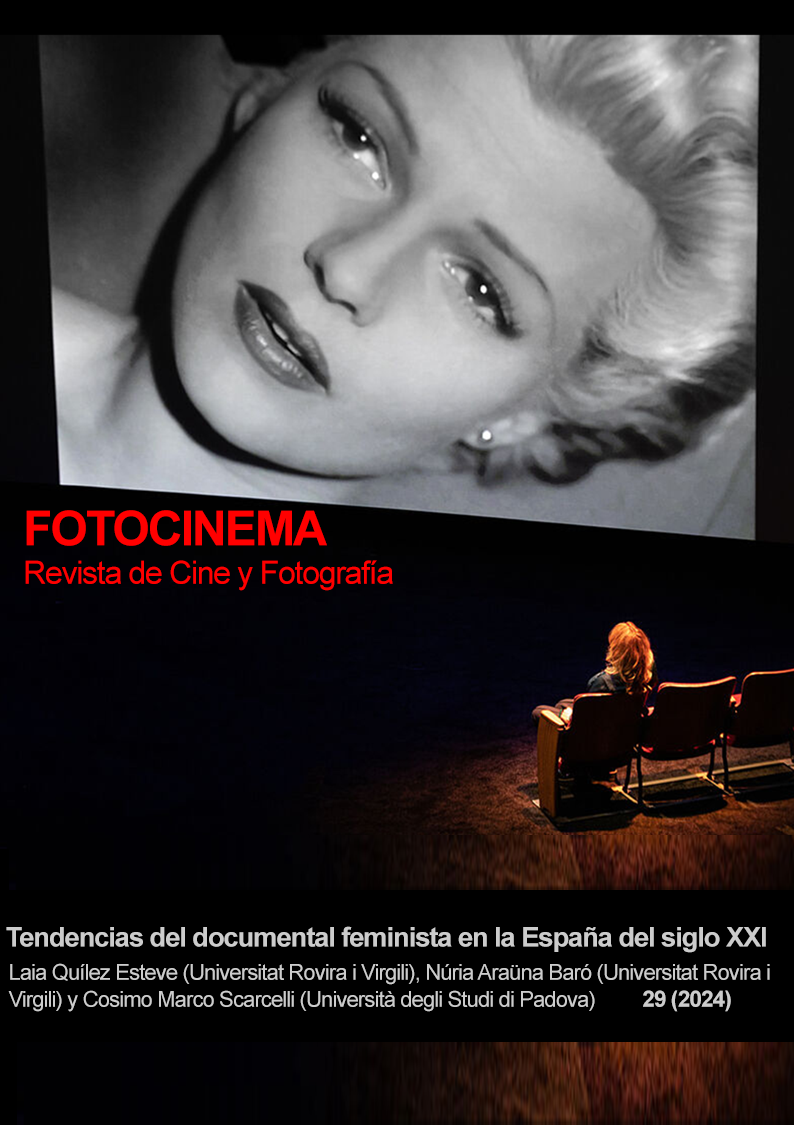Those who lust and Rapa das bestas: of sensoriality as a political tool
DOI:
https://doi.org/10.24310/fotocinema.29.2024.19631Keywords:
Sensoriality, documentary film, feminism, phenomenology, politics, hapticAbstract
Those who lust and Rapa das bestas emerge as two distinctive endeavors within the contemporary Spanish cinematic landscape. Rather than overtly showcasing their feminist stance by directly denouncing female inequality, they do so tangentially, probing into a social practice seemingly distant from gender conflict (a pigeon competition and an ancient tradition of horse shearing). In this study, the meticulous formal work of the two short films is analyzed, drawing upon the destabilization strategies of the gaze utilized in the so-called sensory documentary, evoking an audience experience that transcends purely intellectual engagement to also involve them emotionally and viscerally. It is through the estrangement operated on both the expressive and content levels that these two examples allow for the activation of a political reading of the androcentrism that pervades social spaces without having to explicitly articulate it. Though uncommon, the intertwining of the phenomenological and the semiotic proposed here sketches out new and hopeful paths of feminist positioning within the audiovisual landscape.
Downloads
Metrics
Publication Facts
Reviewer profiles N/A
Author statements
Indexed in
-
—
- Academic society
- N/A
- Publisher
- Universidad de Málaga
References
Araüna, N. y Quílez, L. (2021). Prácticas feministas en el cine documental español contemporáneo. Reflexiones a partir del análisis de La casa de mi padre (Francina Verdés, 2014) y Mater Amatísima (María Ruido, 2018). Arte, individuo y sociedad, 33(1), 105-119. https://dx.doi.org/10.5209/aris.67516
Barker, J. (2009). The Tactile Eye: Touch and the Cinematic Experience. University of California Press.
Burch, N. (2008). Praxis del cine. Fundamentos.
Camborda, J. (Directora). (2017). Rapa das bestas [Película]. Esnatu Zinema.
Deleuze, G. (2001). La imagen-movimiento. Paidós.
Deleuze, G. (2016). Francis Bacon. Lógica de la sensación. Arena libros.
Fonoll Tassier, A., Quílez Esteve, L., y Araüna Baró, N. (2022). Miradas descentradas. Nuevas tendencias en el cine documental español feminista. En R. Arnau Roselló, J. Marzal Felici y T. Sorolla Romero (Eds.), Más allá del documento. Derivas y ampliaciones del cine de lo real contemporáneo (pp. 199-122). Tirant lo Blanch.
French, L. (2018). Women documentary filmmakers as transnational “advocate change agents”. INTER DISCIPLINA, 7(17), 15-29.
French, L. (2021). The Female Gaze in Documentary Film: An International Perspective. Springer.
Ginsburg, F. (2018). Decolonizing Documentary On-Screen and Off: Sensory Ethnography and the Aesthetics of Accountability, Film Quarterly, 72(1), 39-49. https://doi.org/10.1525/fq.2018.72.1.39
Guillamón-Carrasco, S. (2020). Haptic Visuality and Film Narration. Mapping New Women’s Cinema in Spain. Communication & Society, 33(3), 137-147. https://doi.org/10.15581/003.33.3.137-147
Howes, D. (2013). The Expanding Field of Sensory Studies. Sensory Studies. https://www.sensorystudies.org/sensorial-investigations/the-expanding-field-of-sensory-studies/
Husserl, E. (1996). Meditaciones cartesianas. Fondo de Cultura económica.
Johnston, C. (1973). Women’s Cinema as Countercinema. En Johnston, C. (ed.), Notes on Women’s Cinema (pp. 24-31). SEFT.
López Riera, E. (2020). 2020. https://laav.es/2020-elena-lopez-riera/
López Riera, E. (Directora). (2018). Los que desean [Película]. Alina Film.
MacDonald, S. (2015). Sensory Ethnography. En S. MacDonald (Ed.), Avant-Doc. Intersections of documentary and Avant-garde cinema (pp. 511-518). Oxford University Press.
MacDonald, S. (2019). The Sublimity of Document: Cinema as Diorama. Oxford University Press.
MacDougall, D. (Ed.). (2005). The Corporeal Image: Film, Ethnography, and the Senses. Princeton University Press.
MacKenzie, S. (Ed.). (2014). Film manifestos and Global Cinema Cultures. University of California Press.
Marano, F. (2022). The contemplative style in the ethnographic documentary between observation and immersion. Visual Ethnography, 11(2), 39-48.
Marks, L. (2000). The Skin of the film. Duke University Press.
Mayer, S. y Oroz, E. (2011). Lo personal es político: feminismo y documental. Una compilación de ensayos sobre documental y feminismo. INAAC.
Merleau-Ponty, M. (1994). Fenomenología de la percepción. Planeta-De Agostini.
Navarro, V. (2020). On Uncertain Ground: Place and Migration in El Mar La Mar. Film Quarterly, 73(4), 34-40. 10.1525/fq.2020.73.4.34
Oroz, E. (2018). Emergencias y alteridades. Una aproximación a las inscripciones feministas en el documental independiente español contemporáneo. En A. Scholz y M. Álvarez (Eds.), Cineastas Emergentes. Mujeres en el cine del siglo XXI. Madrid / Frankfurt: Iberoamericana / Vervuert.
Rose, G. (2016). Visual Methodologies: An Introduction to Researching with Visual Materials. SAGE.
Rusell, C. (2017). Migrant Cinema: Scenes of Displacement. Cineaste, 43(1), 17-21.
Russell, C. (1999). Experimental Ethnography. Duke University Press.
Selva, M. y Solà, A. (2023). Feminismos y cineastas en el documental español (pp. 290-304). En M. Torreiro y A. Alvarado (Coords.), El documental en España. Historia, estética e identidad. Cátedra.
Sobchack, V. (1992). The Address of the Eye. A phenomenology of film experience. Princeton University Press.
Vannini, P. (2024). The Routledge International Handbook of Sensory Ethnography. Routledge.
Downloads
Published
Versions
- 2024-07-19 (2)
- 2024-07-19 (1)
How to Cite
Issue
Section
License
Copyright (c) 2024 Javier Moral Martín, Beatriz Del Pérez Caz

This work is licensed under a Creative Commons Attribution-NonCommercial-NoDerivatives 4.0 International License.
All contents published in Fotocinema Revista científica de cine y fotografía are protected under the Creative Commons Attribution-NonCommercial-ShareAlike 4.0 International (CC BY-NC-SA 4.0) license. All about this license is available in the following link: <http://creativecommons.org/licenses/by-nc-sa/4.0>
Users can copy, use, redistribute, share and exhibit publicly as long as:
- The original source and authorship of the material are cited (Journal, Publisher and URL of the work).
- It is not used for comercial purposes.
- The existence of the license and its especifications are mentioned.
There are two sets of authors’ rights: moral and property rights. Moral rights are perpetual prerogatives, unrenounceable, not-transferable, unalienable, imprescriptible and inembargable. According to authors’ rights legislation, Fotocinema. Revista científica de cine y fotografía recognizes and respects authors moral rights, as well as the ownership of property rights, which will be transferred to University of Malaga in open access. The property rights are referred to the benefits that are gained by the use or the dissemination of works. Fotocinema. Revista científica de cine y fotografía is published in an open access form and it is exclusively licenced by any means for doing or authorising distribution, dissemination, reproduction, , adaptation, translation or arrangement of works.
Authors are responsable for obtaining the necessary permission to use copyrighted images.














13.png)



